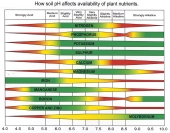posted 6 years ago
I remember seeing something (it was either in Mollison's big ol' permaculture manual, or more recently in Geoff Lawton's online PDC) about letting a mesh/permeable bag dangle in one's rain barrel with limestone because it can harden water that's too soft. I'm particularly interested in this now, not because I'm concerned about it being too soft to drink or anything; I have a 450ish gallon rain barrel system joined together by copper pipes, and I'm concerned that being constantly exposed to 6ish pH rain water could start to corrode the pipes and put copper into the water. My rain barrels are my primary source of irrigation, and while I know that in the short term that's not nearly enough to cause copper toxicity for plants, I like to think about the long, long-term build up in the soil. So all of this leads to several questions:
1) Do other folks use copper plumbing in their cisterns/catchments, and have soil tests revealed any detectable changes in copper accumulation?
2) Does anyone do the baggy of limestone thing in their cisterns/catchments? Is it as simple as putting some actual chunks of full-on rock limestone in the cisterns, or does it have to be relatively processed, like agriculutral limestone (i.e. does or does not rock limestone break down fast enough for it to actually have an effect?)
2a) How much do you have to use to actually affect water pH in a reasonable way? If you have to use very much, it's not sustainable to keep on importing it, plus I could see it as eventually adding too much calcium to the soil, although from what I know of soil chemistry, that's generally a much lesser problem – you have to put in quite a bit to over-lime a field.
3) In theory, couldn't there be two ways that CaCO would be solving my problem? Just talking this out: For one, if the water's pH is raised, that should lead to less corrosion inside of the barrels; and second, once it comes time for the water to go into the soil, if the lime has an alkalizing effect, that would lead to less copper uptake anyway (I recall from a soil class that raising pH was how you overcome copper poisoning in your crops).
Thoughts and experiences are welcomed!





